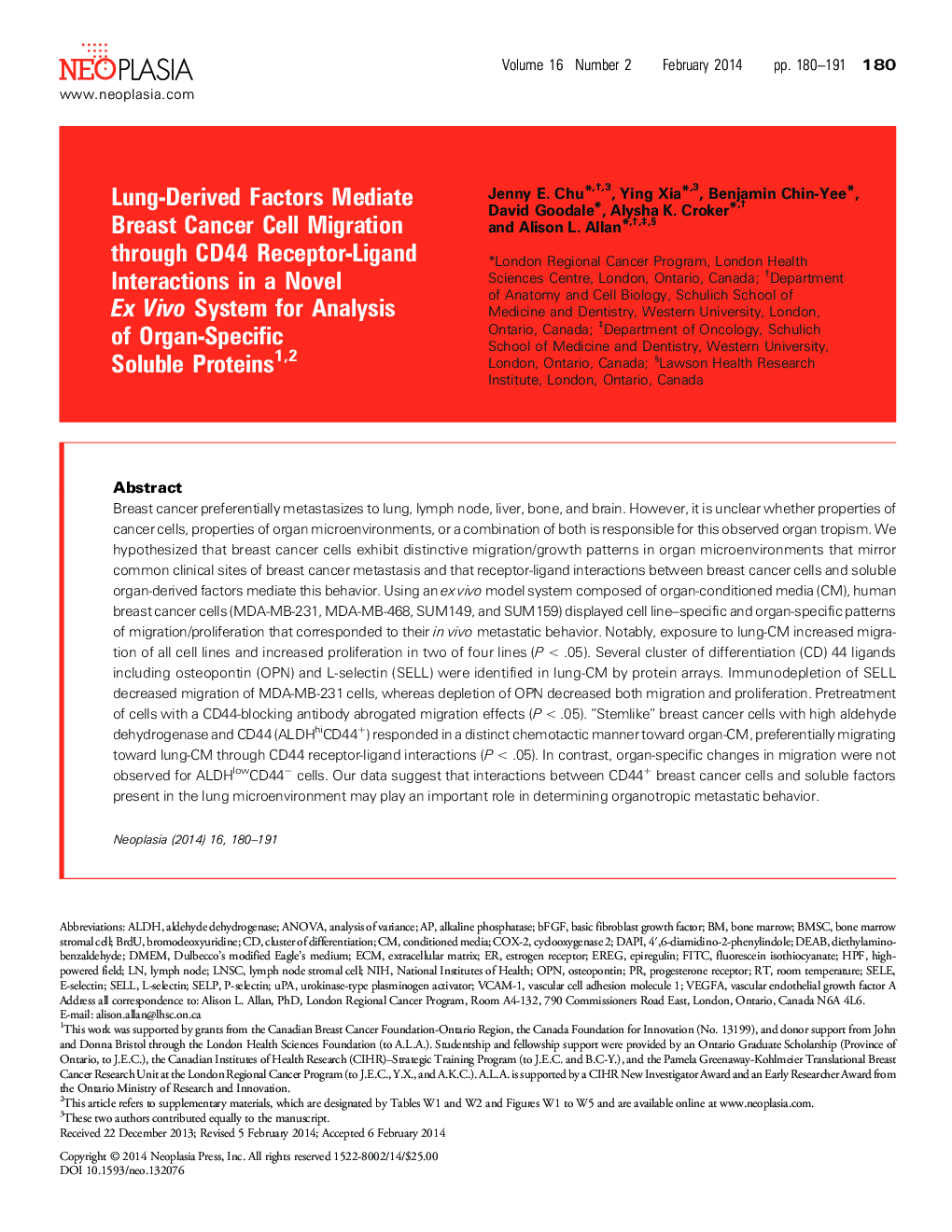| کد مقاله | کد نشریه | سال انتشار | مقاله انگلیسی | نسخه تمام متن |
|---|---|---|---|---|
| 2151437 | 1089992 | 2014 | 18 صفحه PDF | دانلود رایگان |
عنوان انگلیسی مقاله ISI
Lung-Derived Factors Mediate Breast Cancer Cell Migration through CD44 Receptor-Ligand Interactions in a Novel Ex Vivo System for Analysis of Organ-Specific Soluble Proteins
دانلود مقاله + سفارش ترجمه
دانلود مقاله ISI انگلیسی
رایگان برای ایرانیان
کلمات کلیدی
uPAVEGFAhpfBMSCNIHOPNE-selectinP-selectinVCAM-1DAPIL-selectinEpiregulinDEABSELPEREGSELLdiethylaminobenzaldehydeECMALDHCOX-2DMEMFITCbFGFaldehyde dehydrogenase - آلدئید دهیدروژنازAlkaline phosphatase - آلکالین فسفاتاز یا فسفاتاز قلیاییOsteopontin - استئوپنتینele - اوBrdU - بروموداکسی اوریدینbromodeoxyuridine - برومودسوویریدینanalysis of variance - تحلیل واریانسANOVA - تحلیل واریانس Analysis of variancecluster of differentiation - خوشه تمایزRoom temperature - دمای اتاقconditioned media - رسانه های متعلق بهBone marrow stromal cell - سلول استرومال مغز استخوانcyclooxygenase 2 - سیکلوکوکسیژناز 2Vascular endothelial growth factor A - فاکتور رشد اندوتلیال عروقی Abasic fibroblast growth factor - فاکتور رشد فیبروبلاست پایهurokinase-type plasminogen activator - فعال کننده پلاسمینوژن نوع urokinasefluorescein isothiocyanate - فلوئورسین ایسوتیوسیاناتNIH, National Institutes of Health - مؤسسه ملی سلامتExtracellular matrix - ماتریکس خارج سلولیbone marrow - مغز استخوانVascular cell adhesion molecule 1 - مولکول چسبندگی سلولی عروقی 1Lymph node - گره های لنفاویEstrogen receptor - گیرنده استروژنProgesterone receptor - گیرنده پروژسترون
موضوعات مرتبط
علوم زیستی و بیوفناوری
بیوشیمی، ژنتیک و زیست شناسی مولکولی
تحقیقات سرطان
پیش نمایش صفحه اول مقاله

چکیده انگلیسی
Breast cancer preferentially metastasizes to lung, lymph node, liver, bone, and brain. However, it is unclear whether properties of cancer cells, properties of organmicroenvironments, or a combination of both is responsible for this observed organ tropism. We hypothesized that breast cancer cells exhibit distinctive migration/growth patterns in organ microenvironments that mirror common clinical sites of breast cancer metastasis and that receptor-ligand interactions between breast cancer cells and soluble organ-derived factors mediate this behavior. Using an ex vivo model system composed of organ-conditionedmedia (CM), human breast cancer cells (MDA-MB-231,MDA-MB-468, SUM149, and SUM159) displayed cell line-specific and organ-specific patterns of migration/proliferation that corresponded to their in vivo metastatic behavior. Notably, exposure to lung-CM increased migration of all cell lines and increased proliferation in two of four lines (P < .05). Several cluster of differentiation (CD) 44 ligands including osteopontin (OPN) and L-selectin (SELL) were identified in lung-CM by protein arrays. Immunodepletion of SELL decreased migration of MDA-MB-231 cells, whereas depletion of OPN decreased both migration and proliferation. Pretreatment of cells with a CD44-blocking antibody abrogated migration effects (P < .05). “Stemlike” breast cancer cells with high aldehyde dehydrogenase and CD44 (ALDHhiCD44+) responded in a distinct chemotacticmanner toward organ-CM, preferentially migrating toward lung-CM through CD44 receptor-ligand interactions (P < .05). In contrast, organ-specific changes in migration were not observed for ALDHlowCD44- cells. Our data suggest that interactions between CD44+ breast cancer cells and soluble factors present in the lung microenvironment may play an important role in determining organotropic metastatic behavior.
ناشر
Database: Elsevier - ScienceDirect (ساینس دایرکت)
Journal: Neoplasia - Volume 16, Issue 2, February 2014, Pages 180-191, W22-W27
Journal: Neoplasia - Volume 16, Issue 2, February 2014, Pages 180-191, W22-W27
نویسندگان
Jenny E. Chu, Ying Xia, Benjamin Chin-Yee, David Goodale, Alysha K. Croker, Alison L. Allan,